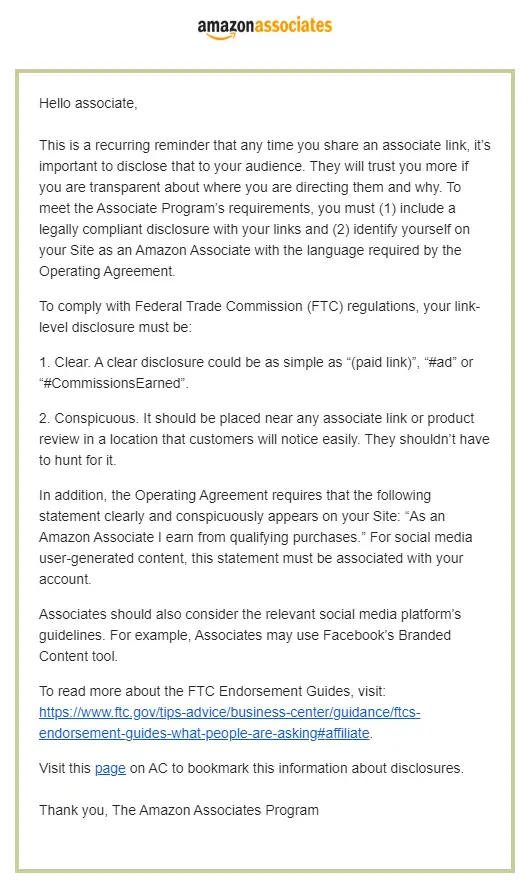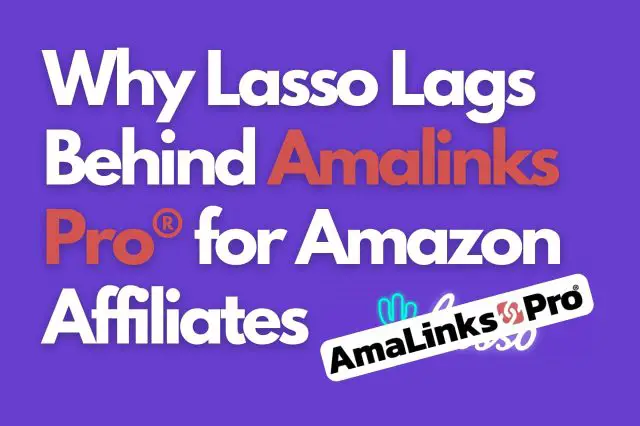In years past, the Amazon affiliate disclosure and the Federal Trade Commission (FTC) guidelines were two entirely separate sets of rules that affiliate marketers had to abide by. To be clear – they still are separate – except that they aren’t anymore for Amazon Associates. If you are promoting products as an Amazon affiliate – you are now required, by Amazon, to abide by the FTC guidelines.
Previously, Amazon had its own disclosure rules that they enforced and they really didn’t care so much if you followed the FTC guidelines or not. As long as you had the Amazon disclosure (aka Amazon disclaimer) statement somewhere on your pages that promote Amazon products – that was good enough for Amazon.
Now, Amazon requires that you also follow the FTC guidelines – which are a little bit more strict and clear as to exactly where you must include affiliate disclosure statements on your website or blog. In other words – to be in compliance with Amazon’s policies – you must also be in compliance with the FTC guidelines.
Amazon Affiliate Disclosure – New Rules (2020)
In late September of 2020, Amazon (US) sent an email to all Amazon Associates regarding upcoming changes to the Amazon Associates Program Operating Agreement. The email included a link to a page that listed out all of the changes that went into effect on October 1, 2020. The most important of these changes, listed at the very top, is the following…
Updated the associate identification requirement to clarify that your identification statement must be prominent.
Then, during the first week of October, Amazon made it extremely clear to all affiliates by sending out the following message in an email…
Full Email Text (from Amazon Associates)
Hello associate,
This is a recurring reminder that any time you share an associate link, it’s important to disclose that to your audience. They will trust you more if you are transparent about where you are directing them and why. To meet the Associate Program’s requirements, you must (1) include a legally compliant disclosure with your links and (2) identify yourself on your Site as an Amazon Associate with the language required by the Operating Agreement.
To comply with Federal Trade Commission (FTC) regulations, your link-level disclosure must be:
1. Clear. A clear disclosure could be as simple as “(paid link)”, “#ad” or “#CommissionsEarned”.
2. Conspicuous. It should be placed near any associate link or product review in a location that customers will notice easily. They shouldn’t have to hunt for it.
In addition, the Operating Agreement requires that the following statement clearly and conspicuously appears on your Site: “As an Amazon Associate I earn from qualifying purchases.” For social media user-generated content, this statement must be associated with your account.
Associates should also consider the relevant social media platform’s guidelines. For example, Associates may use Facebook’s Branded Content tool.
To read more about the FTC Endorsement Guides, visit: https://www.ftc.gov/tips-advice/business-center/guidance/ftcs-endorsement-guides-what-people-are-asking#affiliate.
Visit this page on AC to bookmark this information about disclosures.
Thank you, The Amazon Associates Program
Full Email Screenshot (from Amazon Associates)

This is a BIG deal for Amazon affiliates! A REALLY big deal. This is a monumental new requirement that Amazon has added to its Operating Agreement and MOST Amazon affiliates will need to take some sort of action as a result.
Note: In late October of 2020, Amazon (EU) sent out a very similar email for similar rules effective November 1, 2020.
Explained in plain English
The bottom line is this… Amazon now requires that you abide by FTC guidelines in order to be in compliance with Amazon’s policies.
Before October 1, 2020 – you could be in compliance with Amazon’s rules for affiliate disclosure by simply placing your disclosure/disclaimer statement ANYWHERE on a page that promotes Amazon products as an affiliate. For example: you could simply place your Amazon disclosure statement in the footer of every single page on your site, and this was sufficient to meet Amazon’s policies. And this is exactly what I personally did on all of my sites for many years!
After October 1, 2020 – you now need to place your Amazon affiliate disclosure in a clear and conspicuous location, where readers will easily see it and not have to hunt for it. Generally, this means that readers should see your affiliate disclosure BEFORE they have a chance to see or click on any of your Amazon affiliate links. For example: it would be a good idea to include your Amazon disclosure or disclaimer, within the text, at the top of every post or page that includes affiliate links pointing to Amazon. If not at the very top of every page – your disclosure must appear in the content at least somewhere before your Amazon affiliate links.
FTC Guidelines (Rules) for Amazon Affiliates
The Federal Trade Commission (FTC) in the United States has very specific rules for affiliates. And not just for Amazon affiliates, but for ALL affiliates. Amazon just happens to have one of the biggest affiliate marketing platforms with it’s Amazon Associates program – so Amazon affiliates better pay attention!
In a nutshell – this is what the FTC guidelines state for all affiliates… You MUST tell your audience that you are being compensated. To go one step further, this disclosure MUST be clear and conspicuous and in a prominent location. There are NO exceptions to these rules! No company is too big and no blogger is too small. These disclosure policies apply to everyone and nobody is unaffected by them.
One of the best resources I’ve found on this topic is a blog post from privacypolicies.com. Here is one quote from the article…
What do you have to disclose?
You have to disclose the fact that you have received some form of compensation from the company whose products or services you are posting about.
It is best to describe the nature of your relationship to the company. If you are an employee, say so. If you get a commission from sales, say so. If the company paid for the advertisement, and you neutrally accept any ads that pay the fee, say so. If you own stock in the company, say so.
I highly recommend you read the entire article on privacypolicies.com for clarity on the FTC guidelines for affiliates. Here it is…
https://www.privacypolicies.com/blog/ftc-affiliate-disclosure/
Another phenomenal resource that I found is a Q&A page straight from ftc.gov! On this page, every imaginable question from every possible scenario is covered. Here is one example…
Are you monitoring bloggers?
Generally not, but if concerns about possible violations of the FTC Act come to our attention, we evaluate them case by case. If law enforcement becomes necessary, our focus usually will be on advertisers or their ad agencies and public relations firms. Action against an individual endorser, however, might be appropriate in certain circumstances, such as if the endorser has continued to fail to make required disclosures despite warnings.
To see more questions that people ask the FTC, I highly recommend you check out the full page here…
The Difference Between Amazon’s Policies and the FTC Guidelines
Although there are differences between Amazon’s policy on disclosure and the FTC guidelines – they are essentially one-in-the-same now. But here is the main difference in plain English…
- FTC guidelines are general rules for ALL affiliates that tell you that you must disclose and how and where
- Amazon’s Policies contain very specific rules for AMAZON affiliates stating that you must explicitly reveal your relationship with Amazon
FTC guidelines very clearly state that you must disclose your affiliate relationships clearly and conspicuously in a prominent location. Generally, this means that your affiliate disclosure should be near (almost always BEFORE) any affiliate links so that readers don’t have the chance to click on your affiliate links before seeing the disclosure.
Amazon’s policies, under the ‘Identifying Yourself as an Associate’ section, state the following…
You must clearly and prominently state the following, or any substantially similar statement previously allowed under this Agreement, on your Site or any other location where Amazon may authorize your display or other use of Program Content: “As an Amazon Associate I earn from qualifying purchases.”
It then goes on to declare that you must also include any other disclosures that are applicable by law.
So, basically, Amazon has their own rules and they also require that you abide by other applicable laws and rules.
Can I put the Amazon Associate disclosure in my footer or sidebar?
Technically – you could still have an Amazon Disclosure AND a separate affiliate disclosure. For example – maybe you place your Amazon disclosure in the footer of every single page on your site (or in the sidebar). This would include the proper language to identify yourself as an Amazon Associate and would meet Amazon’s specific requirement for that. Then, you could place your separate affiliate disclosure at the top of every post – which satisfies the FTC requirement and also Amazon’s requirement that you abide by other applicable laws.
Note: regarding affiliate disclosures in sidebars – I would typically avoid this altogether. In fact, I (personally) don’t use sidebars on any of my sites AT ALL anymore. The reason being… most traffic these days is via mobile phones (smaller devices) and most WordPress themes responsive settings push sidebar content below the main content on any given page. So, while the sidebar looks great on desktop (larger screens) – it might never be seen at all on mobile or the reader doesn’t scroll all the way to the end.
Are you confused about all of this yet? I’ll try to clear this up for you with an example…
Where Should I Place My Amazon Affiliate Disclosure?
Depending on how you want it to look on your site – you have a couple of different options. Here’s an example for if you wanted to use a separate FTC disclosure in a prominent location and put the Amazon disclosure somewhere else.
An FTC disclosure at the top of every post might look like this…
We earn commissions (at no additional cost to you) if you purchase products from retailers after clicking on a link from our site.
And the required Amazon disclosure could be placed somewhere else on the page, like at the bottom of the post or in the footer. It should look like this…
As an Amazon Associate, I earn from qualifying purchases.
What is the Best Practice?
It’s probably best to just come up with a statement that satisfies both rules and place it in a prominent location – typically at the very top of every post that contains affiliate links. The basic Amazon affiliate disclosure statement is good enough, as long as it is placed in a prominent location. Only placing that statement in the footer is not good enough – because it would be possible for readers to see and click on affiliate links before seeing the affiliate disclosure.
What Amazon Affiliate Disclosure Should I Use?
Looking at the rule, directly from Amazon’s policy page, again…
You must clearly and prominently state the following, or any substantially similar statement previously allowed under this Agreement, on your Site or any other location where Amazon may authorize your display or other use of Program Content: “As an Amazon Associate I earn from qualifying purchases.”
This means that the new (shorter) statement is perfectly acceptable…
As an Amazon Associate, I earn from qualifying purchases.
The old required statement, described as “substantially similar statement previously allowed”, looked like this…
[SiteNameHere.com] is a participant in the Amazon Services LLC Associates Program, an affiliate advertising program designed to provide a means for sites to earn advertising fees by advertising and linking to products on Amazon.com. Amazon and the Amazon logo are trademarks of Amazon.com, Inc, or its affiliates.
Either of these statements, or something very similar, is fully acceptable by Amazon for its requirements. To be 100% safe – just be certain that you disclose your affiliate relationship with Amazon specifically.
Amazon Affiliate Disclosure Examples
Would you like to see some examples for disclosure statements as used by some of the top Amazon affiliate marketers out there? Before I show you these examples, though… I must forewarn you that many affiliate websites DO NOT comply with Amazon’s rules as they should and some don’t even properly comply with the FTC guidelines! Regardless – it’s always good to see what others are doing.
Here is a link to an extraordinary blog post that I wrote – 7 Successful Amazon Affiliate Website Examples (Find out which ones are breaking the rules!)
Within that post, you’ll see what some of the big players use for their affiliate disclosure statements. You can even click through to the sites to see that they are doing live, today!
Here is what I typically do on my sites…
I came up with my own affiliate disclaimer statement, in my own words, that satisfies both the FTC guidelines and the Amazon requirements. The statements I use on my various sites tend to vary slightly, but they are all very similar. Here is a copy/paste of a statement that I’ve used before…
Hey! By the way… any links on this page that lead to products on Amazon are affiliate links and I earn a commission if you make a purchase. Thanks in advance – I really appreciate it!
I typically place this disclaimer statement manually, within my content, just before the first Amazon affiliate link on the page. So, the disclaimer statement is NOT at the very top of the post – but it IS clear and conspicuous, within the content, just before the first Amazon affiliate link on the page.
How to Automatically Insert an Amazon Affiliate Disclosure in WordPress
So, what if you want to add the proper disclosure statements on your blog – but you don’t want to manually revisit every single post to do so. If only there were a plugin for that…
Behold! There is! I found a great WordPress plugin that is available for FREE in the WordPress repository. It’s called WP Affiliate Disclosure.
WP Affiliate Disclosure gives you complete control. You use a WP editor to edit your disclosure statement to look however you want. You choose whether you want to display your disclosure on all Posts/Pages or just on certain Posts/Pages (based on Categories or Tags).
For example: if you want to display a certain disclosure ONLY on posts that contain Amazon affiliate links – you could categorize or tag all of those posts accordingly – then use this plugin to automatically insert an Amazon disclosure statement at the top of all of those posts!
How do I tell Google to not index my disclosure statement?
Great question! If you are automatically placing disclosure statements at the top of every post – you certainly don’t want Google using your disclosure or disclaimer statements as automated meta descriptions or description snippets for your posts. It’s really easy to add an HTML tag to the beginning and end of your statement to tell Google to ignore it.
You simply add the following HTML tags before and after your statement…
- <!–googleoff: index–>
- <!–googleon: index–>
So, a typical Amazon disclosure statement (in HTML mode) would look something like this…
<!–googleoff: index–>As an Amazon affiliate, we earn from qualifying purchases.<!–googleon: index–>
Be sure to use these tags in the HTML editor in WordPress (called the Text editor or Code editor) – DO NOT use HTML tags in the Visual editor! Here is a screenshot of what it looks like within the WP Affiliate Disclosure interface…

Frequently Asked Questions from AmaLinks Pro® Users
I would like to know by using the AmaLinks Pro® Showcases and Comparison Tables, does this cover the conditions that need to be met?
AmaLinks Pro® Showcase Boxes and Comparison Tables have nothing to do with the Amazon disclosure requirement. You should absolutely place your Amazon disclosure requirement on any page that includes these elements – BEFORE any Amazon affiliate links appear.
Are you saying that that sentence is enough? Do we need to add text stating “(paid link)” or “#ad” or “CommissionsEarned” next to or underneath that sentence and will that be enough?
Or
Is Amazon asking that the text “(paid link)” or “#ad” or “CommissionsEarned” should display on every individual product showcase and table?
I believe that those examples that Amazon gave regarding “(paid link)” or “#ad” or anything similar was in regards to posting Amazon affiliate links on social media. Separate disclaimer statements absolutely DO NOT need to be placed on every single Showcase Box or Comparison Table. One clear and conspicuous Amazon affiliate disclosure/disclaimer statement, at the top of the page (or before any Amazon affiliate links), is plenty sufficient and meets Amazon requirements and FTC guidelines.
You certainly CAN include more disclosure or disclaimer statements wherever and however often you like – but it is not required that you place affiliate disclosure statements next to every single link on every single page on your website.
When Amazon says “It should be placed near any affiliate link or product review, do they mean at the top of the blog page? Or next to every product Showcase?
My concern is that if you say that Amazon is stating that the disclosure wording needs to be on every individual product Showcase and Comparison Table… Will AmaLinks Pro® update the Showcase Boxes and Comparison Tables with the appropriate “(paid link)” or “#ad” or “CommissionsEarned” within the Showcase Boxes and Comparison Tables?
I just want to make sure I understand this correctly, as I know we need to have the disclaimer at the top (which we already do) but it seems that Amazon is saying that something is required “in addition” and are asking for more than just adding some extra text to our existing disclaimer sentence at the top, from my understanding.
As explained above – Amazon is not asking website owners to add disclaimer statements next to every single link. It sounds like you are confusing social media requirements with web page requirements.
AmaLinks Pro® will NOT be adding separate disclaimers to Showcase Boxes or Comparison Tables or any other link type that we offer. It is not a requirement by Amazon to place separate disclosures next to every single link on any given page.
We believe that we are providing extraordinary service with this blog post alone – to clearly explain the new rules. Our plugin does not need to be modified whatsoever to meet Amazon’s requirements or the FTC guidelines.
I’m working also on Amazon France ( EU) and I’m wondering if this rule is obliged in all Amazon stores or just in Amazon US?
I shared this in some France forums and they answered me that it is not necessary to put the message in the first of every post! Just putting it in the footer of your site is enough!
I think this rule is applicable in Amazon US only ( FTC ) and not in Amazon EU.
I believe that your sources in your forums are incorrect. Yes, FTC guidelines only apply to the US, but Amazon EU did send out an email on October 23rd, 2020 with very similar new requirements. They changed the language to say that…
“You must clearly and prominently state the following, or any substantially similar statement…”
Here is a link explaining the changes for Amazon EU…
https://affiliate-program.amazon.co.uk/help/operating/compare?ref_=pe_3641111_512142831
To be safe – I would absolutely always place your disclosure statement within your content and BEFORE any Amazon affiliate links. Just placing your disclosure statement in the footer or sidebar is no longer sufficient.




